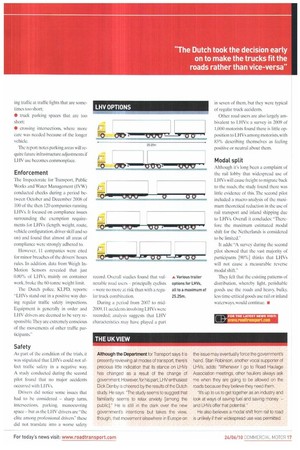utch courage
Page 16

Page 17

If you've noticed an error in this article please click here to report it so we can fix it.
Can a report into the Dutch experience with LHVs offer hope that longer, heavier vehicles could be on UK roads sooner rather than later?
Words: Dominic Perry A RECENT REPORT from the Dutch government Longer and Heavier Vehicks in the Netherlandswill offer UK operators a strange experience: on the one hand many will be cheered by the positive information contained within it, on the other they will be left slightly depressed (and possibly mystified) by the continued absence of LHVs from the UK's roads.
The Dutch report, issued by the Rijkswaterstaat (the Ministry of Transport, Public Works and Water Management), summarises the Netherlands' experience with LHVs since their small-scale introduction in 1995.
Broadly speaking, it confirms what the proponents of LHVs have been saying all along: LHVs are cleaner, more efficient, less harmful, more cost-effective and do not create the sort of problems suggested by their detractors (increased accidents, modal shift from rail to road and so on).
Although technically allowed on Dutch roads from 1995, their widespread use was not officially sanctioned until 2001 when the Dutch government launched a small-scale trial comprising four operators running four vehicles. Following evaluation of phase one, a second pilot was launched in August 2004, initially with 66 participants running 100 LHVs, increasing to 76 participants with 162 vehicles by its end in November 2006.
The third pilot or -experience phase" was launched in November 2007 with 196 participants operating 429 LHVs. This part of the project is, according to the report. to "study the effects of an increasing number of LHVs in the Netherlands, in terms of traffic safety, traffic management and modal split".
If the results of stage three are positive, it may be extended beyond its proposed end date of November 2011.
LHVs require a special exemption permit to operate and drivers also need an extra qualification to be allowed to pilot them.
Impacts on infrastructure
The Dutch took the decision early on to make the trucks nt the roads rather than vice-versa. LHVs are allowed on three different road types: motorways; roads in "LHV-core areas" such as ports, industrial estates and so on, which are assessed by a local or regional authority to determine their suitability; and roads that connect motorways and -LHV-core areas': One key finding in Holland has been that LHVs actually cause equal or less damage both in terms of deformation (stretching and warping of the road surface) and fatigue (the breaking up of the material) damage than a regular truck. The report nows: "Increasing the weight of an LHV to 60 tonnes should not have a negative impact on pavement [road surface] quality as long as one does not exceed the maximum axle load."
ing traffic at traffic lights that are sometimes too short; • truck parking spaces that are too short: • crossing intersections, where more care was needed because of the longer vehicle.
The report notes parking areas will require future infrastructure adjustments if LI I V use becomes commonplace.
Enforcement
The Inspectorate for Transport, Public Works and Water Management (IVVV) conducted checks during a period between October and December 2008 of 100 of the then 120 companies running LHVs. It focused on compliance issues surrounding the exemption requirements for LHVs (length, weight, route, vehicle configuration, driver skill and so on) and found that almost all areas of compliance were strongly adhered to.
However, 11 companies were cited for minor breaches of the drivers hours rules. In addition. data from Weigh InMotion Sensors revealed that just 0.80% of LHVs, mainly on container work, broke the 60-tonne weight limit.
The Dutch police, KLPD, reports: "LHVs stand out in a positive way during regular traffic safety inspections. Equipment is generally in order and LHV drivers are deemed to be very responsible. They are extremely conscious of the movements of other traffic participants."
Safety
As part of the condition of the trials, it was stipulated that LHVs could not affect traffic safety in a negative way. A study conducted during the second pilot found that no major accidents occurred with LHVs„ Drivers did notice some issues that had to be considered — sharp turns, intersections, parking, manoeuvring space — but as the LHV drivers are "the elite among professional drivers" these did not translate into a worse safety record, Overall studies found that vulnerable road users — principally cyclists — were no more at risk than with a regular truck combination.
During a period from 2007 to mid2009, 11 accidents involving LHVs were recorded; analysis suggests that LHV characteristics may have played a part in seven of them, but they were typical of regular truck accidents.
Other road users are also largely ambivalent to LHVs: a survey in 2009 of 1,000 motorists found there is little opposition to LHVs among motorists, with 83% describing themselves as feeling positive or neutral about them.
Modal split
Although it's long been a complaint of the rail lobby that widespread use of LHVs will cause freight to migrate back to the roads. the study found there was little evidence of this. The second pilot included a macro-analysis of the maximum theoretical reduction in the use of rail transport and inland shipping due to LHVs. Overall it concludes: "Therefore the maximum estimated modal shift for the Netherlands is considered to be limited.
It adds: "A survey during the second pilot showed that the vast majority of participants 190%] thinks that LHVs will not cause a measurable reverse modal shift."
They felt that the existing patterns of distribution, whereby light, perishable goods use the roads and heavy, bulky, less time-critical goods use rail or inland waterways, would continue. •
Fr+FOR THE LATEST HEWS VISIT: anAnurnadtransport.com












































































































































